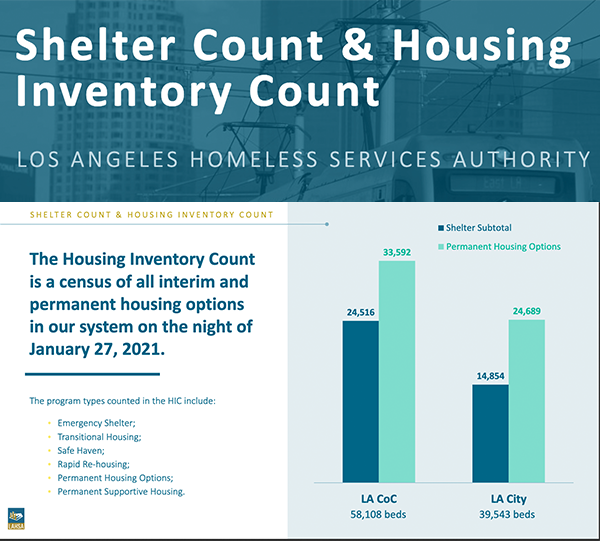The homeless rehousing system has shown a strong performance in the past year despite the profound challenges presented by the COVID-19 pandemic, based on the results of the 2021 Housing Inventory Count (HIC) and Shelter Count released by the Los Angeles Homeless Services Authority (LAHSA) Wednesday.
In her presentation Heidi Marston, Executive Director of LAHSA, focused on four main insights from the HIC and Shelter Count and the rehousing system’s impact:
Through unprecedented coordination and a critical influx of state and federal emergency funding, the LA region’s rehousing system’s response to COVID-19 saved lives.
This year’s HIC and Shelter Count showed a strong performance for the rehousing system, even against the challenges of COVID-19.
The Los Angeles region needs to build a more balanced system with more housing options. A balanced rehousing system has five permanent housing exits for each shelter bed; the Los Angeles system is closer to 1 to 1.
Outside of the rehousing system, all stakeholders must work together to reverse the decades of policy decisions that created our homelessness crisis and have disproportionately affected Black people.
“Our rehousing system’s response to COVID saved lives because of unprecedented coordination across sectors and an influx of state and federal emergency funding,” Marston said. “We must build off of that momentum as we emerge from the pandemic to build the infrastructure necessary to address our homelessness crisis and collectively confront the conditions that continue to push people into homelessness.”
The Housing Inventory Count is a census of all interim and permanent housing options in the homeless rehousing system at a given point-in-time. This year, the Housing Inventory Count occurred on January 27.
Through the Housing Inventory Count, LAHSA found that the LA region’s shelter capacity on any given night was 24,616 beds, a 57% increase over the last three years. The agency also reported 33,592 permanent housing options, an increase of 16% over the same time period.
LAHSA reported these positive results despite the global pandemic causing a considerable strain on its shelter supply. In accordance with CDC guidelines, all of Los Angeles County’s congregate shelters had to decrease their bed count through a process called decompression. However, strategic investments by the federal, state, and local governments through Project Roomkey and Project Homekey helped make up for the loss of capacity.
The results of the Housing Inventory Count also provide insights on whether the homeless rehousing system possesses the right balance of permanent housing to shelter.
A balanced homeless rehousing system has an average of five housing exit options for every shelter bed. This ratio of housing exits to shelter beds leads to shorter lengths of stay in shelter, more interim bed turnover, faster housing placements, and more exits to permanent housing.
LAHSA reported that its system’s ratio is closer to 1 to 1, leading to people experiencing homelessness becoming stuck in shelter and on the streets. The shortage of affordable housing options in LA is the result of decades of intentional policy choices to downzone housing capacity and exclude and marginalize people of color. As a result, Los Angeles now has the fewest number of housing units per adult of any major American city.
“It is critical that our region continues to add to our housing and shelter supply. We need more strategic investments that create low-barrier and private shelter options in areas of the county where the need is greatest,” continued Marston. “But shelter without a permanent housing option leaves people stuck. Critical to this equation is ensuring housing on the other side. LA County also needs 509,000 affordable housing units to meet the current need, and the housing market is saturated with a 5% vacancy rate. Thanks to Prop. HHH, there are nearly 13,000 permanent housing units on the way, but we need more affordable housing options to solve our region’s housing crisis.”
LAHSA and its partners also carried out the Shelter Count – a census of people in shelter at a point-in-time. Like the Housing Inventory Count, the Shelter Count was performed on January 27, 2021.
The Shelter Count revealed that there were 17,225 people in shelter on the night of the count, which is virtually unchanged from the previous year. LAHSA cited that without the addition of 2,357 Project Roomkey beds and 497 Project Homekey beds, there could have been a more significant drop in the shelter count due to decompression.
Following the advice of public health officials, LAHSA did not conduct an Unsheltered Count in 2021 to protect the 8,000 volunteers needed to complete the Count each year from COVID-19. The agency is planning to resume the Unsheltered Count in 2022.
View the presentation
View the presentation deck
View the data summaries
View the key messages
https://www.lahsa.org/news?article=849-lahsa-releases-2021-housing-inventory-count-and-shelter-count-results

